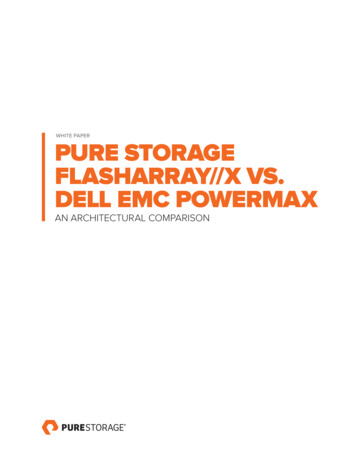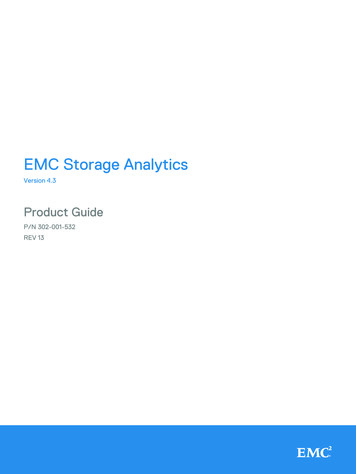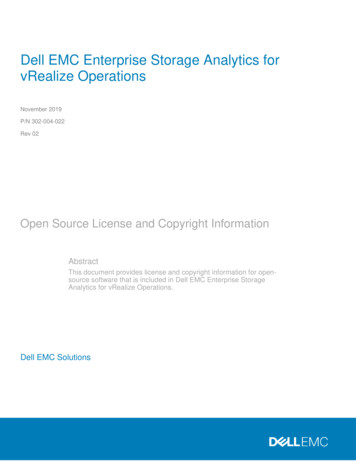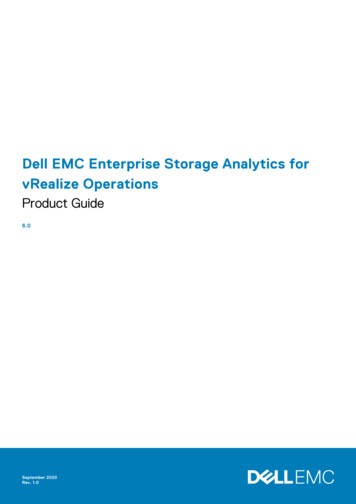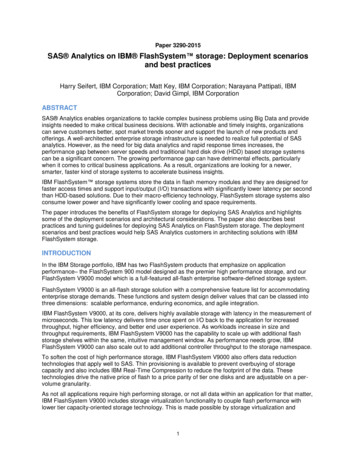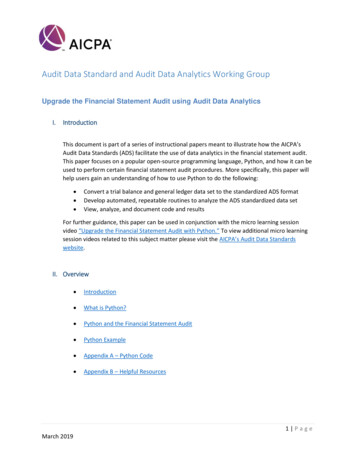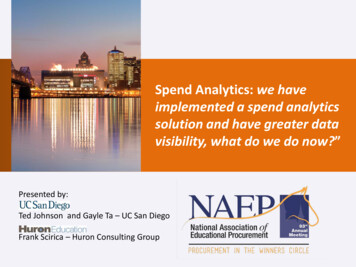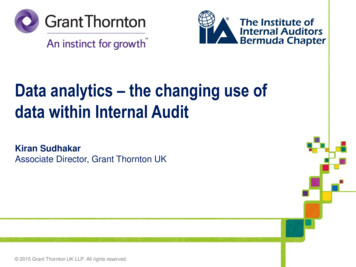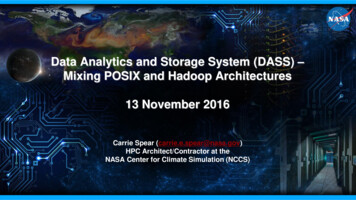
Transcription
National Aeronautics and Space AdministrationData Analytics and Storage System (DASS) –Mixing POSIX and Hadoop Architectures13 November 2016Carrie Spear (carrie.e.spear@nasa.gov)HPC Architect/Contractor at theNASA Center for Climate Simulation (NCCS)www.nasa.gov
DASS ConceptRead access from all nodes within theADAPT system Serve to data portal services Serve data to virtual machines foradditional processing Mixing model and observationsADAPTAnalytics through web services or higherlevel APIs are executed and passed downinto the centralized storage environmentfor processing; answers are returned. Onlythose analytics that we have written areexposed.HyperWallRead access from the HyperWall tofacilitate visualizing model outputsquickly after they have been created.Mass StorageRead and write access from the massstorage Stage data into and out of thecentralized storage environment asneededClimate Analytics asa ServiceDataAnalyticsand StorageSystem(DASS) 10 PBNote that more than likely all the services will still have local file systems toenable local writes within their respective security domain.HPC - DiscoverWrite and Read from all nodes within Discover – models writedata into GPFS which is then staged into the centralizedstorage (burst buffer like). Initial data sets could include: Nature Run Downscaling Results Reanalysis (MERRA, MERRA2) High Resolution Reanalysis
Data Analytics Storage System (DASS)Data movement and sharing of data across services within theNCCS is still a challengeLarge data sets created on Discover (HPC) On which users perform many analyses And may not be in a NASA Distributed Active Archive Center (DAAC)Create a true centralized combination of storage and computecapability Capacity to store many PBs of data for long periods of time Architected to be able to scale both horizontally (compute and bandwidth) andvertically (storage capacity) Can easily share data to different services within the NCCS Free up high speed disk capacity within Discover Enable both traditional and emerging analytics No need to modify data; use native scientific formatsYour Title Here4
Initial DASS Capability Overview Initial Capacity 20.832 PB Raw Data Storage 2,604 by 8TB SAS Drives 14 Units 28 Servers 896 Cores 14,336 GB Memory 16 GB/Core 37 TF of computeRoughly equivalent to the compute capacity ofthe NCCS just 6 years ago!Designed to easily scale both horizontally(compute) and vertically (storage)Your Title Here5
DASS Compute/Storage UnitsHPE Apollo 4520 (Initial quantity of 14) Two (2) Proliant XL450 servers, each with Two (2) 16-core Intel Haswel E5-2697Av4 2.6 GHzprocessors 256 GB of RAM Two (2) SSD’s for the operating system Two (2) SSD’s for metadata One (1) smart array P841/4G controller One (1) HBA One (1) Infiniband FDR/40 GbE 2-port adapter Redundant power supplies 46 x 8 TB SAS drives70 x 8 TB 560 TBD6000XL450XL45046 x 8 TB 368 TBApollo 452070 x 8 TB 560 TBD6000Two (2) D6000 JBOD Shelves for each Apollo 4520 70 x 8TB SAS drivesYour Title Here6
DASS Compute/Storage UnitsTraditionalData moved fromstorage to compute.Open, Read, Write,MPI, C-code,Python, etc.MapReduce, Spark,Machine Learning,etc.POSIX InterfaceRESTful Interface,Custom APIs,NotebooksInfiniband, EthernetCloudera and SIAShared Parallel FileSystem (GPFS)Shared Parallel FileSystem (GPFS)Hadoop ConnectorNative Scientific Data stored inHPC Storage orCommodity Servers and StorageEmergingAnalytics moved fromservers to storage.Open Source Software Stack on DASSServers Centos Operating System Software RAID Linux Storage Enclosure Services Pacemaker Corasync
Spatiotemporal Index Approach (SIA) and HadoopUse what we know about the structured scientificdataCreate a spatiotemporal query model to connect thearray-based data model with the key-value basedMapReduce programming model using grid conceptBuilt a spatiotemporal index to Link the logical to physical location of the data Make use of an array-based data model within HDFS Developed a grid partition strategy to Keep high data locality for each map task Balance the workload across cluster nodesA spatiotemporal indexing approach for efficient processing of big array-based climate data with MapReduceZhenlong Lia, Fei Hua, John L. Schnase, Daniel Q. Duffy, Tsengdar Lee, Michael K. Bowen and Chaowei YangInternational Journal of Geographical Information Science, 0
Analytics Infrastructure TestbedTest Cluster 1SIAClouderaHDFS 20 nodes (compute and storage)ClouderaHDFSSequenced dataNative NetCDF data Put onlyTest Cluster 2SIAClouderaHadoop ConnectorGPFS 20 nodes (compute and storage)ClouderaGPFSSpectrum Scale HadoopTransparency ConnectorSequenced data– Put and CopyNative NetCDF Data– Put and CopyTest Cluster 3SIAClouderaHadoop ConnectorLustre 20 nodes (compute and storage)ClouderaLustreLustre HAM and HALSequenced data– Put and CopyNative NetCDF Data– Put and Copy
DASS Initial Serial Performance Compute the average temperature forevery grid point (x, y, and z)Vary by the total number of yearsMERRA Monthly Means (Reanalysis)Comparison of serial c-code toMapReduce codeComparison of traditional HDFS(Hadoop) where data is sequenced(modified) with GPFS where data isnative NetCDF (unmodified, copy)Using unmodified data in GPFS withMapReduce is the fastestOnly showing GPFS results tocompare against HDFS
DASS Initial Parallel Performance Compute the average temperature forevery grid point (x, y, and z)Vary by the total number of yearsMERRA Monthly Means (Reanalysis)Comparison of serial c-code with MPIto MapReduce codeComparison of traditional HDFS(Hadoop) where data is sequenced(modified) with GPFS where data isnative NetCDF (unmodified, copy)Again using unmodified data in GPFSwith MapReduce is the fastest as thenumber of years increasesOnly showing GPFS results tocompare against HDFS
Future of Data AnalyticsDataInMemoryClimate/Weather Models (HPC) ng data from memory.SIAIndexMLSparkHDFSC, IDL, PythonPost process data on disk.Continue to enable traditionalmethods of post processing.Future HPC systems must be able to efficiently transform information into knowledgeusing both traditional analytics and emerging machine learning techniques. Requires the ability to be able to index data in memory and/or on disk and enableanalytics to be performed on the data where it resides – even in memory All without having to modify the data
Hadoop Connector RESTful Interface, Custom APIs, Notebooks MapReduce, Spark, Machine Learning, etc. Infiniband, Ethernet Cloudera and SIA Traditional Data moved from storage to compute. Emerging Analytics moved from servers to storage. Open Source Software Stack on DASS Servers Ce

